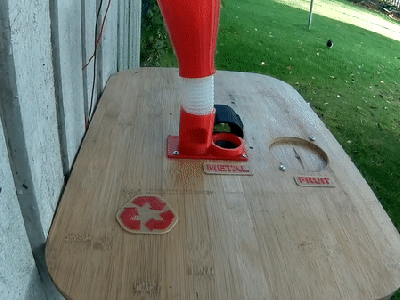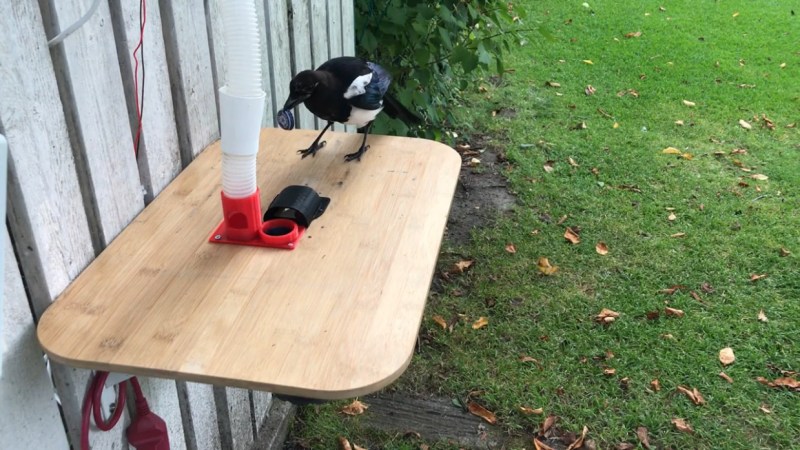Despite epithets like “bird-brain,” our feathered friends are actually pretty smart. Being able to maneuver in three dimensions at high speed must have something to do with it, and the cognitive abilities of birds are well-documented and still being researched. So it naturally makes sense to harness avian brainpower to keep one’s yard clean, right?
 For the record, the magpies that [Hans] is training are very intelligent and strikingly beautiful birds who delight in swooping down to harass people, and who will gladly steal food from other birds and then poop on it and fly away. So they’re jerks, but that doesn’t mean they can’t be useful jerks. The goal with his BirdBox system is to use classic operant conditioning, where a desired voluntary behavior is reinforced by a reward. In this case, the reward is a treat dispensed by a 3D-printed vibratory dispenser when the bird collects a bottlecap from the yard and deposits it in the proper slot. The video below shows the birds doing exactly what they’re supposed to do.
For the record, the magpies that [Hans] is training are very intelligent and strikingly beautiful birds who delight in swooping down to harass people, and who will gladly steal food from other birds and then poop on it and fly away. So they’re jerks, but that doesn’t mean they can’t be useful jerks. The goal with his BirdBox system is to use classic operant conditioning, where a desired voluntary behavior is reinforced by a reward. In this case, the reward is a treat dispensed by a 3D-printed vibratory dispenser when the bird collects a bottlecap from the yard and deposits it in the proper slot. The video below shows the birds doing exactly what they’re supposed to do.
[Hans] tells us that the trick is getting the birds to accept the BirdBox and to have them integrate it into their “patrol schematic” of their territory. Once that’s done, it’s a simpler matter to have them associate the bottlecaps with the reward. The other challenge is making everything bulletproof, or in this case magpie-proof. Did we mention that magpies are jerks?
The possibilities for trading peanuts for yardwork are endless; [Hans] mentions plans he has for fallen fruit clean-up, and mentions a persistent garden slug problem that the birds might be employed to remediate. If you want to try this, it might be a good idea to brush up on the work of [B.F. Skinner] and his pigeons of war.
















For how many peanuts does a magpie work each day?
Are their beaks big enough to collect wallnuts?
Already years ago I read a similar story about using magpies to clean up public spaces such as parks. Don’t know how that ended though.
This is nothing short of genius!
make it small, tiny, cheap/printable/ easily repeatable, and we can probably get a BOATLOAD of plastics and trash out of our ecosystems…. but what does that mean for how birds learn and evolve to eat… might turn into an issue. HOWEVER enlisting them to help work on human caused environmental problems could be a huge plus to our lack of willingness to change. I can imagine parking lots where birds trade out trash for food all day long.
Okay, saying they are incredibly intelligent is a misnomer simply by comparing the size of theor brains to ours. But I’m also not saying they’re dumb.
Take a current generation, Intel of AMD, CPU with 8 core and SMT. A beast of a chip that can drink down over 150 W. Try to use it for crypto mining and you’ll have a lot of heat and a power bill you don’t want. You can do better with a GPU, but really, an ASIC is where you do.
Our brains are those CPUs (ignore the parallel and serial processing differentiations) whereas the bird’s brains are ASICs for flight and navigation, et al. Their brains are *highly* specialized.
That’s not true. Brains of Corvids are quite special. They are not asics at all. Birds and mammals separated almost 300 million years ago, and have been evolving along different lines. Turns out that especially Corvids have parts of their brain that serve the same function as what would be different parts in human brains. Also the density of bird brains is higher, they pack more neurons in less space than humans, about twice more per volume. The brains are also laid out quite differently. But scientists are finding that especially Corvids have many of the same functionalities as human brains, except executed in different parts of the brain.
Some interesting read: https://theness.com/neurologicablog/index.php/crow-intelligence/
There’s lots more if you search for it. The intelligence of a crow or a Raven actually approaches that of a Chimpanzee.
Our brains are highly specialized too. What we consider higher functions are a thin layer of flexibility on top of a whole lot of automation and shortcuts. We just prefer to pretend we’re much more in control.
Corvids like magpies dot test: they are self aware enough that if you mark one while it’s unconscious and then show it a mirror it will figure the mirror out and try to groom the mark in a spot it can’t see. That’s nearly primate level intelligence. Also there’s evidence they have some form of culture with family groups remembering grudges against particular people for generations.
Corvids – european magpies are part of that family with biggest of them ravens are really smart they learn how to plan jobs with multiple steps use tools and so on, they can even learn to talk(simple few words communication but its not just brainless repetition).
Big parrots have similar inteligence – especially Kea from NZ.
I love our european magpies they are ruffians of bird nation but charming and cheerful you can befriend and train them even those living freely if they see you aren’t danger and sometimes give food they will approach you.
Magpies are horrible and a source of wanton violence throughout Australia every spring. Think of them as flying chickens with anger problems.
When I lived in Queensland, I found talking to them worked.
Each day on my regular route I talked directly to the magpies when they perched after their attack, not shout or such like, and after while they would still fly down as if to strafe me, but they’d miss by a good few feet. They’d also perch closer as if interested in listening to what I was saying.
Basically I made it clear I was not a menace to them.
THey’re pretty smart birds.
I hear giving them snacks works
You cheeky chap :)
This looks like a similar project as the CrowBox ( http://www.thecrowbox.com/ ), but where i have never seen a video of the crowbox achieving it’s goal (getting corvids to bring coins) this one does. I really like this setup, the hard part is not the build but training the birds towards the desired behaviour , but i am sure [Hans] will explain that part in his upcoming video’s.
Apparently there there is also an installation where corvids return crushed soda cans, it would be great to adopt this setup to that kind of litter. As we walk around in the neighborhood, we always crush cans and get rid of the waste. If only the corvids could do the heavy lifting…
Even if Corvids are uncanningly smart, they still need the right motivation to do things. Just like human kids. :)
this bird is already much more intelligent than “some” people in my region…
This is a Eurasian magpie, and unlike their Australian cousins, they don’t engage in swooping behaviour.
https://www.youtube.com/results?search_query=magpie+swooping
Some years ago I was on vacation in France, and while visiting a village some locals starting talking to me, and trying to warn me of something. I did not understand them, what they said might as well have been French.
Some 5 minutes later a white seagull like creature came flying about and shitting on my head and clothes.
The Australian Magpies aren’t corvids though.
brilliant project in many ways.
A bottle -> food exchanging machine is one thing, but how do you tell/teach the birds what they should do.
I’m aware of the fact that birds can copy behavior. But, how does the (first) bird know what to do?
Checkout the video on http://www.thecrowbox.com, it tells you a bit about the training.
I don’t know how he did it, but my best guess is to put a bottle cap on the edge of the hole so that the first bird knocks it in by accident and gets the reward. Repeat the process by planting a few more bottle caps on the table and the bird will learn that bottle cap in hole = reward.
I have already saw ( sorry no link) the same thing, but this time bird need to bring back coins found in streets
The real trick ofcourse is to make clear to them they need to insert that bottle cap
So if you put the garbage in the proper container you get a reward? I wonder if we could apply this to humans?
yes, Germany has pet bottle collecting system where you put plastic bottles in big ATM like machine and recieve fev cents back. In Poland shops buy back glass beer bottles (not all sadly some breweries use own design bottles that aren’t part of buyback) and there are recycling centres that buy back alu cans, steel, alloys, bronze/copper and paper whole groups of homeless usually live off this roaming cities searching for things they could collect and sell.
I would love to see a project like this training urban pigeons and crows to turn in cigarette butts for food. That’s partly because the butts are annoying litter, and partly because I think it would be funny to see the birds snatching cigarettes from smokers.
It does work. They remember those who’ve given them food, won’t swoop you, and will introduce their juveniles to you. “This funny-looking creature will give you food if you don’t attack it. Try flapping your wings, or vocalising. They seem to like that.”
I can walk underneath the nest of the local tribe during breeding season, and all they do is vocalise a bit. Nice call they have.
P.S. Australian magpies aren’t corvids. From wiki: “the European magpie is a member of the Corvidae, while its Australian counterpart is placed in the family Artamidae (although both are members of a broad corvid lineage). “
https://hackaday.com/2017/10/09/trading-bird-food-for-cigarette-butts/